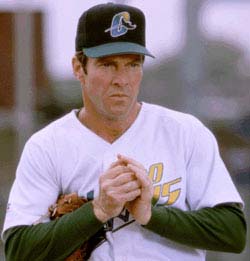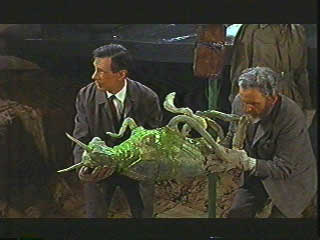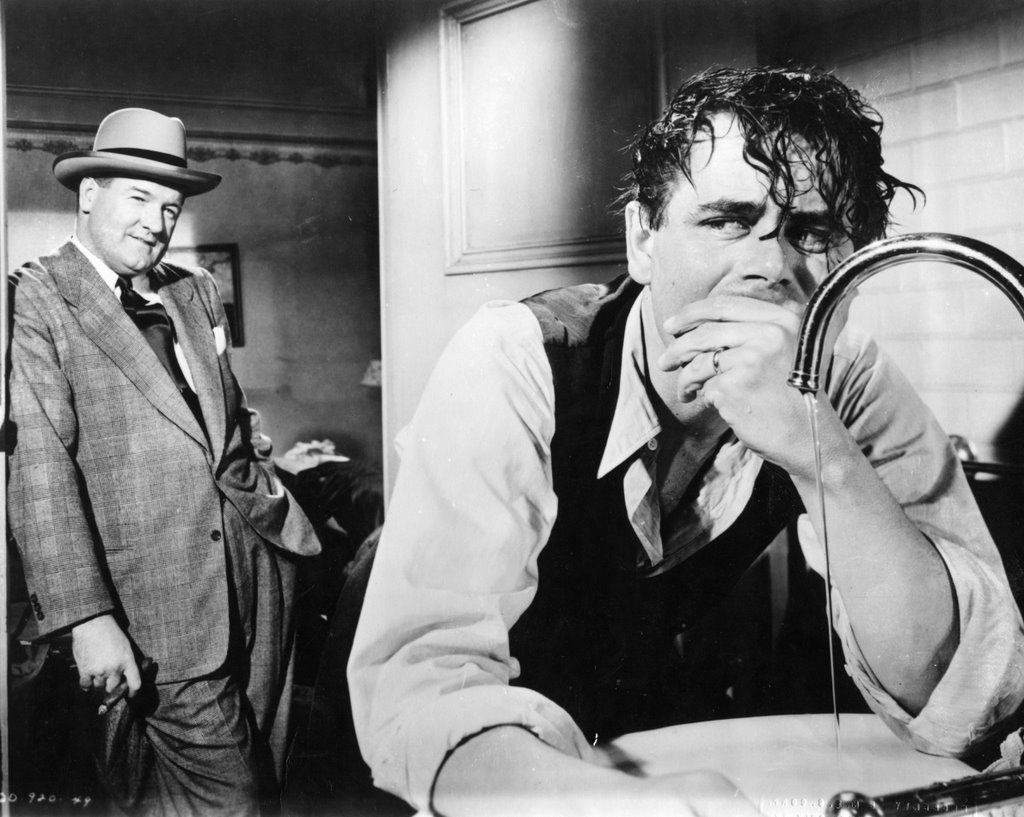TCM Salutes Richard Carlson on April 29
By Ed Garea
Richard
Carlson, noted for his sci-fi films of the ‘50s, is being feted by TCM with a
night of his psychotronic movies.
Beginning
at 8 pm with It Came From Outer Space, it continues through to the
last showing at 4 am with the Bert I. Gordon “classic,” Tormented.
For
me as a kid, Carlson was (and still is) one of my favorite actors. He first
came to my attention as Dr. Jackson in Abbott and Costello’s Hold That
Ghost, where he helped the boys solve the mystery of the bad-tasting water
at the derelict hotel they inherited while still finding time to romance the
gorgeous Evelyn Ankers.
As
time passed, I found him starring in more films I considered essential: It
Came From Outer Space, The Ghost Breakers, and, of course, the
classic Creature From the Black Lagoon. These firmly cemented him
in my mind as an actor to watch. As I grew older and my tastes broadened from
horror and sci-fi to other genres, I found him in such films as Back
Street, The Little Foxes, and the highly enjoyable, but
strange, White Cargo. As with other movie stars I idolized as a
youth, his presence in a movie was enough to make me watch. But it was his
sci-fi roles I loved most.
The
odd thing was that he was renowned for these roles in the ‘50s, though he made
only four of those films – It Came From Outer Space (1953), The
Magnetic Monster (1953), Riders to the Stars (1954),
and Creature From The Black Lagoon (1954), and these were made
within a two-year period.
I’ll
examine the first three of these in this article, as Creature From The
Black Lagoon deserves a separate article of its own.
8:00 pm – It Came From Outer Space (Universal, 1953) Director: Jack Arnold. Cast: Richard
Carlson, Barbara Rush, Charles Drake, Joe Sawyer, Russell Johnson, Kathleen
Hughes, & Dave Willock. B&W, 81 minutes.
The
collaboration of producer William Alland and director Jack Arnold gave fans
many memorable sci-fi films in the ‘50s, including Tarantula, This
Island Earth, The Mole People, The Monolith Monsters, and The
Incredible Shrinking Man. This effort was their first. It’s also noteworthy
as the screenwriting debut of author Ray Bradbury. He wrote a story treatment
for the studio entitled “The Meteor,” and was hired to expand it. The result
was that he penned the complete screenplay. The studio then brought Harry Essex
aboard to do the necessary polish, and for his efforts, Bradbury was paid in the
neighborhood of $3,000.
Not
only was the film Universal’s first attempt at science fiction, it was also
their first attempt at the new technology of 3-D. The result was a solid hit
and one of the top grossing films for the year.
Carlson
is schoolteacher and amateur stargazer John Putnam. His girlfriend is fellow
schoolteacher Ellen Fields (Rush). One night, John and Ellen see a meteor crash
in the desert. He rouses his friend Pete (Willock) to take him to the site in
his helicopter, and the three of them go to investigate. Landing at the
site, only John is able to descend into the crater, where he spots a spaceship
and a brief glimpse of its hideous passenger before a landslide, caused by the
alien, covers it. Since he’s the only one who has seen the ship and its pilot,
no one believes his story. But John soon finds that some of the townsfolk
are not what they seem, especially his friends, telephone linesmen George
(Johnson) and Frank (Sawyer). After chasing Frank and George into a dark alley,
they reveal to him that they are alien replicas of the men, sent into town to
get necessary parts for the ship and that the real Frank and George are fine
and will be released once the ship is repaired.
However,
Sheriff Matt Warren (Drake), alarmed by the disappearance of both people and
electrical equipment, gets involved in the mystery. Meanwhile the alien George
abducts Ellen and a replica Ellen is sent to lure John to a mineshaft, which
connects the downed spacecraft to the outside world. There the alien explains
to him that their race is an advanced one and will continue to be peaceful as
long as they’re not disturbed while repairing the ship. It also explains that,
while they desire contact, humans are not developed enough to accept their
frightening appearance. John informs the sheriff of his meeting, but the
sheriff decides to take action and rounds up a posse of men to confront the
aliens.
John
races to the mine ahead of the group to warn the aliens, but he finds they no
longer trust him and are readying their laser weapon to defend themselves.
However, he convinces them that if they release the abducted people as a show
of faith, the men will cease attacking. The aliens reluctantly agree and the
abducted humans leave the mineshaft unharmed, as Frank and John dynamite the
entrance to the mine. As the townspeople watch the ship fly out of the crater
back towards space, Sheriff Matt asks if they have left for good, to which John
replies that they will return when we are ready to accept them.
Considering
its budget ($800,000), It Came From Outer Space is a
remarkable film. The photography of Clifford Stine, combined with director
Arnold’s pacing, makes the film look like anything but a B product. It
also neatly captures the paranoia of the Atomic Age, especially concerning
UFOs. Even the climactic scene with the townsfolk coming together to take on
the aliens, which by this time had become a cliché, thanks to countless
westerns and horror movies that preceded it, is handled with care and style.
About the only glaring weak spot is the revelation of the alien, which is a
constant weak point of almost every film of the genre, since the appearance of
the monster can never equal our imagining of it. Bradbury himself had
complained about it in several interviews: “I warned them not to bring the
‘monster’ out in the light - ever. They ignored my advice. The bad moments in
the film come when the monster does just that: stops being mysterious, steps
out, and becomes a laugh riot."
But
perhaps its real influence can be seen in a story about Bradbury attending a
review screening of Close Encounters of the Third Kind. He ran into
the film’s director, Steven Spielberg, who told him that the inspiration for Close
Encounters lay in the fact that he had watched It Came From Outer
Space numerous times as a kid.
9:30 pm – The Magnetic Monster (UA, 1953) Director: Curt Siodmak. Cast: Richard Carlson,
King Donovan, Jean Byron, Harry Ellerbe, Leo Britt, Leonard Mudie, & Byron
Foulger. B&W, 76 minutes.

This
was one of my favorite sci-fi films when I was young. I liked it because it
didn’t feature the usual monster and had enough scientific mumbo-jumbo to keep
me interested. For me, it was never enough that the monster was; no, I always
wanted to know how and why it came about. The film covered this well enough for
me to warrant repeat viewings whenever it was shown. But it had been almost 40
years since I last saw it on television or in the cinema, and when TCM ran it a
few months ago I was looking forward to seeing it once again. Of course, there
is the inevitable clash between the film as it is and one’s cherished memories
of said film, and this was true when I saw it again after that long absence.
It’s almost like a cultural clash as I asked myself exactly what it was when I
saw it as a kid. When it was over, I realized it was better than what I just
finished watching, but it was definitely not the classic I had built it up to
in my mind’s eye.
Nonetheless,
it’s a good, well-plotted movie, even if some of its points are wildly absurd
by today’s understanding of physics. Dr. Jeffrey Stewart (Carlson) and Dr. Dan
Forbes (Donovan) are investigators for the U.S. government’s Office of
Scientific Investigation (OSI). As the movie opens, Forbes is sharing his findings
about high levels of radiation in the area with Stewart when they are summoned
to a store whose owner is complaining that all his appliances have suddenly
magnetically bonded. Upon investigating, they determine the source of the
magnetism is the office above the store. There they discover the body of man
that has died from radiation poisoning. He is, they learn, the assistant to
Howard Denker (Mudie), who has disappeared along with his briefcase. A manhunt
goes out and Denker is apprehended, dying, on a plane. In his briefcase is his
creation – he tells Forbes and Stewart that it’s an atomic isotope he created
by bombarding serranium with alpha particles. This altered its properties,
making it magnetic. Oh, Denker says before departing this world, it must
constantly be fed an electric charge or it will grow uncontrollably.
They
attempt to control it in a university cyclotron, but it explodes, magnetizing
everything near it and doubling its size. The only way to control it, Stewart
and Forbes reason, is to overfeed it and thus render it harmless. The only
power source with the capacity to do just that is the top-secret subterranean
deltatron (see picture above) off the coast of Nova Scotia. The scientist in charge of the
deltatron, Dr. Benton (Britt), protests, as this planned overfeeding will
destroy his toy, but the Canadian government overrides him and allows Forbes
and Stewart to proceed. However, during the course of their work, Benton
goes over the edge and pulls a “bwa-ha-ha” moment by sabotaging the floodgates.
If they do not desist, everyone in the building will drown. But Stewart thwarts
Benton’s plans by cutting the cable to the floodgates and allowing them to
close and protect the employees gathered behind. The experiment works, though
the deltatron is destroyed in the process. The isotope is rendered harmless and
the world is safe once again.
The
problem with The Magnetic Monster lies neither with the acting
nor the direction. The acting is uniformly excellent – Carlson and Donovan are
absolutely convincing in their roles and carry the film nicely. Ditto with the
direction. Siodmak keeps the action going at a brisk pace and there are
practically no dead spots in the film. It is also one of the first – and very
few – movies to address the horrors of the atomic age in a clear and sober
manner. The problem with the movie is its science. One does not have to possess
as Ph.D in physics to see the obvious holes in the plot. First off, Dr. Denker
supposedly created this isotope at the university, then, because he didn’t want
to share his discovery, he took it with him and rented an office in which to
set up shop. If he created his isotope in a university lab, then the government
would be in on it and there would be absolutely no way Denker could take his
project and go home. Secondly, the electrical energy he would need in his
storefront lab would blow every fuse in the city. Imagine his electrical bills.
And thirdly, check out the “deltatron” itself. It comes to us audience members
courtesy of stock footage from a 1934 German film entitled Gold about
the attempts of a British scientist to turn base metals into gold with the help
of an atom smasher. Check out the giant vacuum tubes on the thing. No cyclotron
I’ve ever seen photos of had vacuum tubes. However, ignore the science and what
we have is a most enjoyable and cerebral combination science fiction/mystery.
Trivia: Co-producers Ivan
Tors and Richard Carlson saw this as a pilot, so to speak, for a new television
show based on the adventures of OSI investigators entitled A Men.
However, the proposed show failed to get off the ground and the partnership
between Tors and Carlson dissolved. Tors would bring back the OSI for two
following films, Riders to the Stars and Gog. Herbert
L. Strock co-directed, but got into trouble with the Director’s Guild as he
also functioned as the film’s editor. In Riders to the Stars,
Carlson got the credit while Strock actually directed the film.
11:00 pm – Riders to the Stars (UA, 1954) Director: Richard Carlson (Herbert L. Stock –
uncredited) Cast: Richard Carlson, William Lundigan, Herbert Marshall, Martha
Hyer, Dawn Addams, Robert Karnes, & King Donovan. B&W, 82 minutes.
Producer
Tors’ follow-up to the suspenseful The Magnetic Monster is
this rather dull entry about attempts to get a man into space. A group of
highly-qualified single men, including Dr. Richard Stanton (Lundigan) and Dr.
Jerry Lockwood (Carlson), are recruited for a secret project. After a series of
grueling physical and psychological tests, the remaining four are told of the
project’s purpose.
Dr.
Stanton’s father, Dr. Donald Stanton (Marshall), the man in charge of the
project, has been working with his colleagues on manned space travel. But they
have discovered in the course of their study that even the finest quality steel
turns brittle in empty space. Yet meteorites are not subject to this problem,
and the scientists want to know why. To do this they have to recover one before
it hits the atmosphere, to learn how their “outer shell,” as they put it,
protects them. So this is the project for which the four astronauts have been
recruited: to go into space and capture a meteor. Three - Stanton, Lockwood and
Walter Gordon (Karnes) - accept the challenge while the fourth quits in
disgust.
They
each pilot one-man rockets into space. While attempting to capture his meteor,
Gordon is killed. Lockwood, seeing his friend killed before him, becomes
unhinged to the point where he aims his ship into the deepest reaches of space
and pushes the petal to the metal. Stanton, despite warnings that he’s running
low on fuel and could burn up on re-entry, nonetheless captures a meteor and
brings it to Earth, earning him a kiss from the project’s female scientist, Dr.
Flynn (Hyer).
Unlike The
Magnetic Monster, which didn’t let the technobabble get in the way of the
suspense, Riders to the Stars is drowned in its own blather.
Like the earlier Destination Moon, the science alone was the reason to
watch. There was no hero, villain, or monsters to fight. Unfortunately, without
these there is also little, if any, tension, aside from the climatic scenes in
space. The performances are decent and the direction workmanlike, but nothing
really stands out.
Tors
apparently learned his lesson from this film, for in his next foray, Gog,
we have a hero, an unidentified villain, and two monsters in the form of robots
Gog and Magog, who are turned into killing machines by the unidentified
villain, which is only seen as a silent aircraft passing over the installation.
(Commies, perhaps?)
















